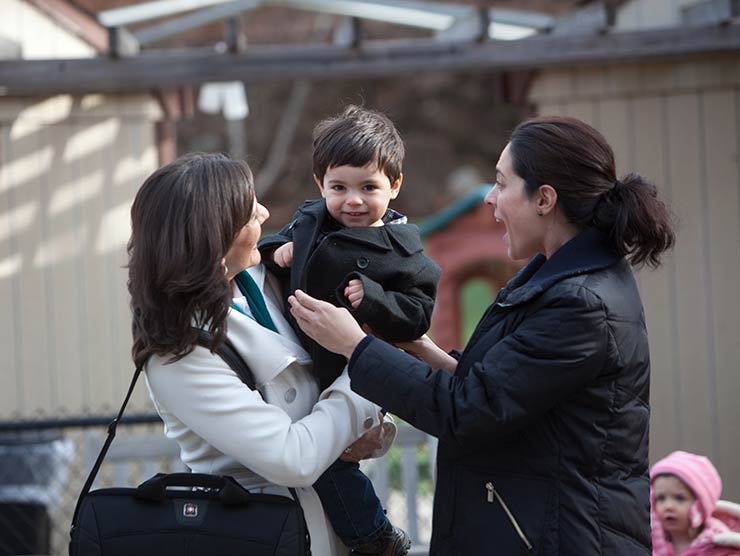All children worry or feel anxious at times, and to some extent, that’s good. Worry can alert your child to potential hazards or encourage them to plan ahead. But what should you do if your child seems to worry excessively? Here are a few ideas:
Empathize. One of the quickest ways to diffuse worry (whether you’re 4 or 40) is to talk it through with someone you trust. Don’t dismiss your child’s worry, e.g., “That’s silly. There’s nothing to worry about,” but listen and respond with empathy. Say, “I can see this is really bothering you. Tell me more.”
Practice mindfulness. Neuropsychiatrist Daniel Siegel coined the phrase, “upstairs/downstairs brain” to describe how the brain works. The upstairs brain refers to the portion of our brain that manages language, impulse control, and logic/reason, while the downstairs brain (sometimes called the reptilian brain) manages basic bodily functions and emotions. When children feel strong emotions, their downstairs brain is often running the show. Teaching your child basic mindfulness techniques like belly breathing or meditation can help them more quickly regain regulation (and return to the upstairs brain).
Face your fears and find solutions. As parents, it’s natural to want to protect our children, but avoiding fears can actually reinforce them, according to Danny Pine, a child and adolescent psychiatrist at the National Institute of Mental Health. Help your child identify what it is about a certain situation that causes worry. Analyze it and come up with some steps to overcome it. For example, say your child is afraid of talking to adults. Talk with your child about why it might feel scary and offer another perspective. “I can see why you might feel afraid. I felt that way too when I was your age. I’ve realized though that most adults are really nice, and like talking to kids.” Start by encouraging your child to talk to one familiar, kind adult. Practice ahead of time and offer some ideas about what to say.
Create comfort. Jim Greenman, former vice president of Education and Development at Bright Horizons and author of “What Happened to My World,” described four pillars all children need to feel safe and secure: people (family and friends), places (our home and familiar places like the park, school, or library), rituals (bedtime stories), and routines (a predictable daily schedule). Warm, nurturing moments like reading a bedtime story, having family dinner together, going on a daily walk, or even just spending 10 minutes talking and playing every morning can help soothe a child’s worry and anxiety.
Get support. Check with your pediatrician if your child displays physical symptoms of anxiety and worry, such as frequent headaches or stomachaches, or if their worry is impacting their ability to go to school, play, etc.
Empathize. One of the quickest ways to diffuse worry (whether you’re 4 or 40) is to talk it through with someone you trust. Don’t dismiss your child’s worry, e.g., “That’s silly. There’s nothing to worry about,” but listen and respond with empathy. Say, “I can see this is really bothering you. Tell me more.”
Practice mindfulness. Neuropsychiatrist Daniel Siegel coined the phrase, “upstairs/downstairs brain” to describe how the brain works. The upstairs brain refers to the portion of our brain that manages language, impulse control, and logic/reason, while the downstairs brain (sometimes called the reptilian brain) manages basic bodily functions and emotions. When children feel strong emotions, their downstairs brain is often running the show. Teaching your child basic mindfulness techniques like belly breathing or meditation can help them more quickly regain regulation (and return to the upstairs brain).
Face your fears and find solutions. As parents, it’s natural to want to protect our children, but avoiding fears can actually reinforce them, according to Danny Pine, a child and adolescent psychiatrist at the National Institute of Mental Health. Help your child identify what it is about a certain situation that causes worry. Analyze it and come up with some steps to overcome it. For example, say your child is afraid of talking to adults. Talk with your child about why it might feel scary and offer another perspective. “I can see why you might feel afraid. I felt that way too when I was your age. I’ve realized though that most adults are really nice, and like talking to kids.” Start by encouraging your child to talk to one familiar, kind adult. Practice ahead of time and offer some ideas about what to say.
Create comfort. Jim Greenman, former vice president of Education and Development at Bright Horizons and author of “What Happened to My World,” described four pillars all children need to feel safe and secure: people (family and friends), places (our home and familiar places like the park, school, or library), rituals (bedtime stories), and routines (a predictable daily schedule). Warm, nurturing moments like reading a bedtime story, having family dinner together, going on a daily walk, or even just spending 10 minutes talking and playing every morning can help soothe a child’s worry and anxiety.
Get support. Check with your pediatrician if your child displays physical symptoms of anxiety and worry, such as frequent headaches or stomachaches, or if their worry is impacting their ability to go to school, play, etc.





